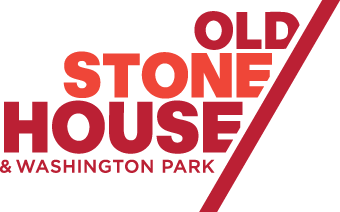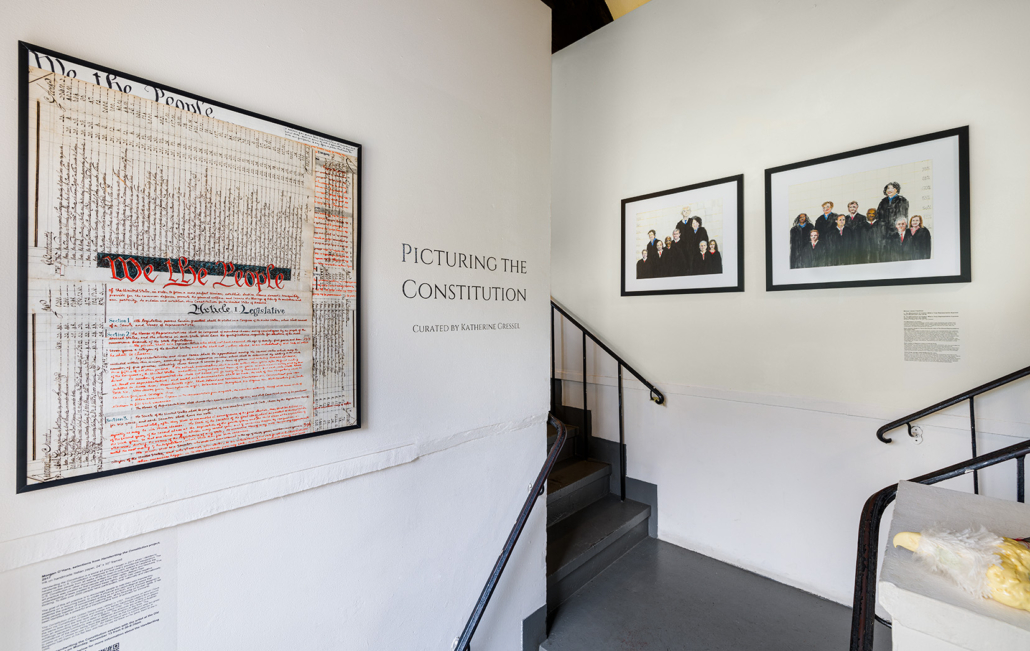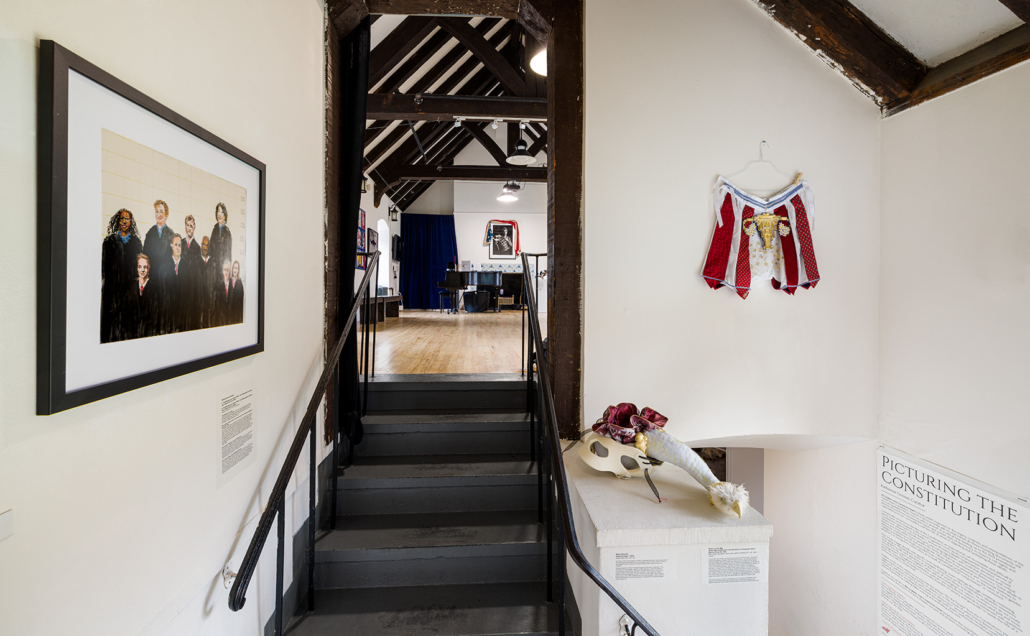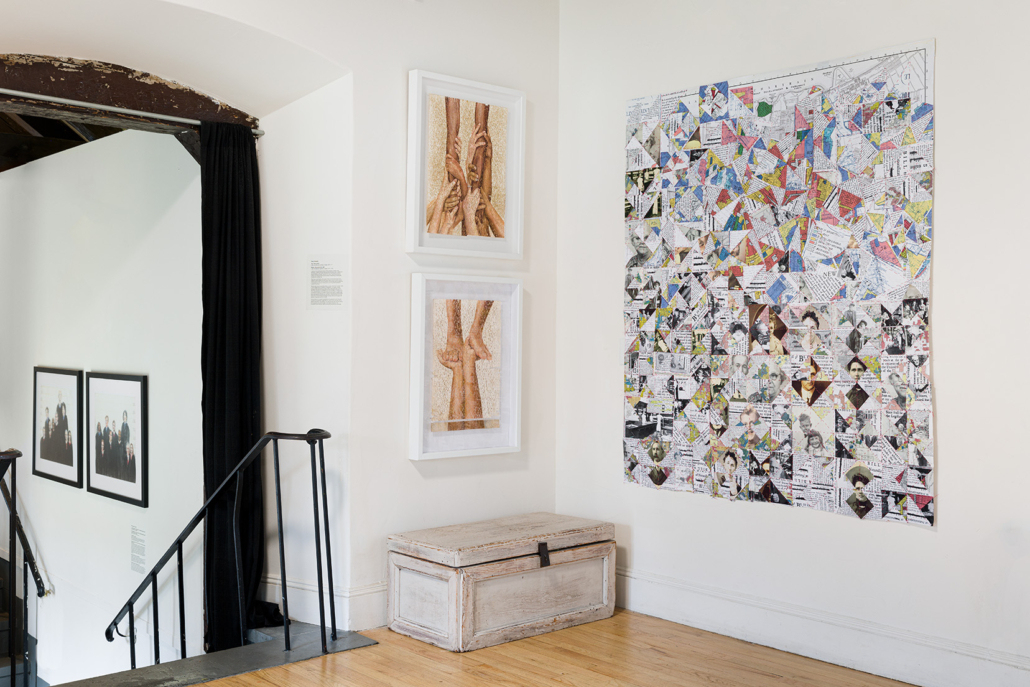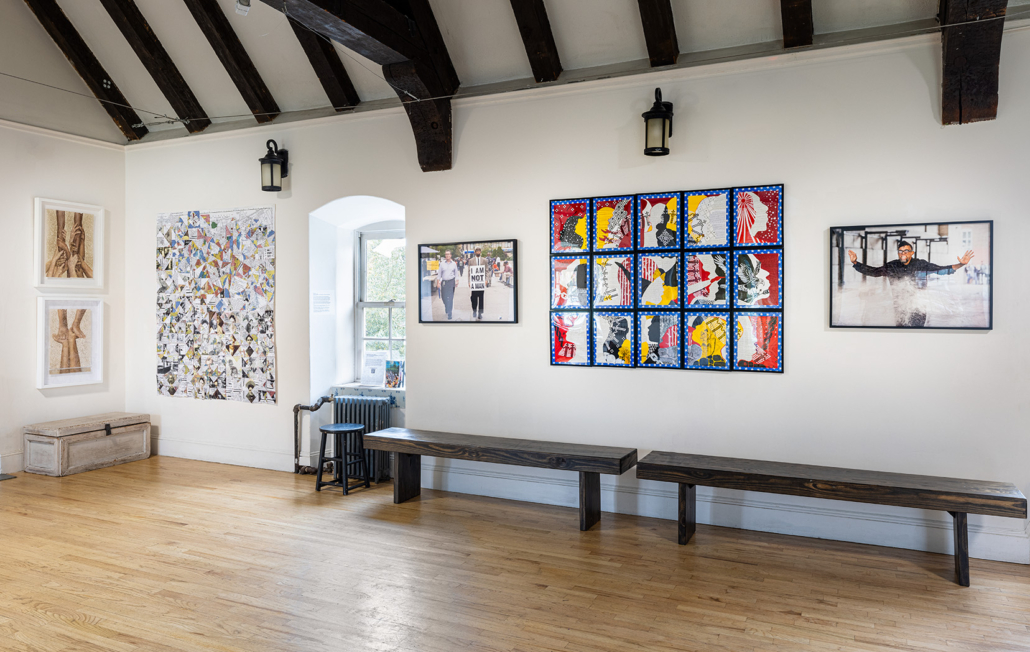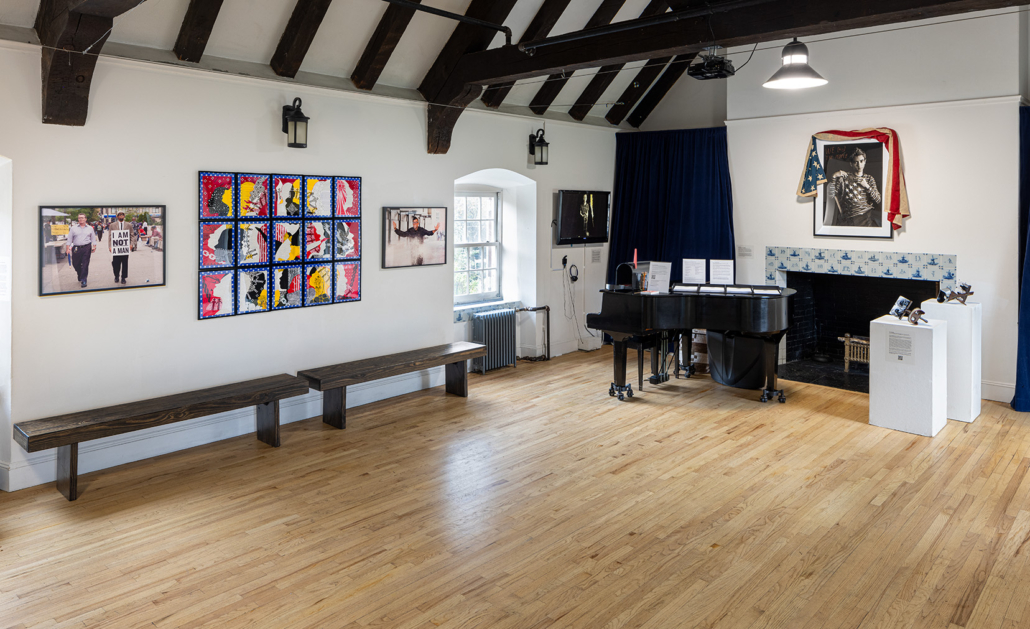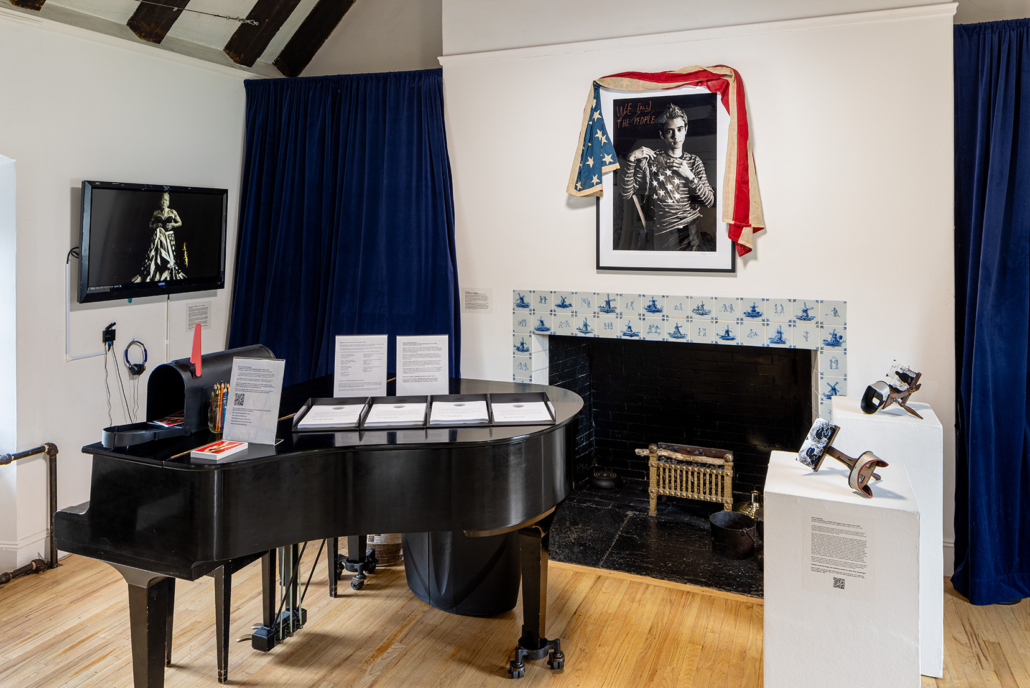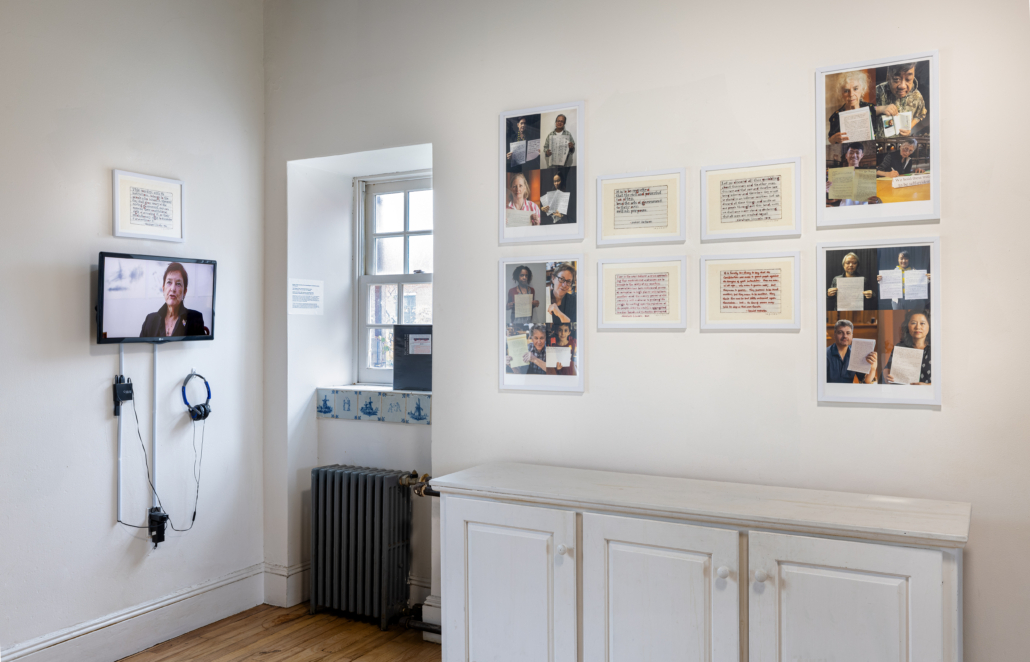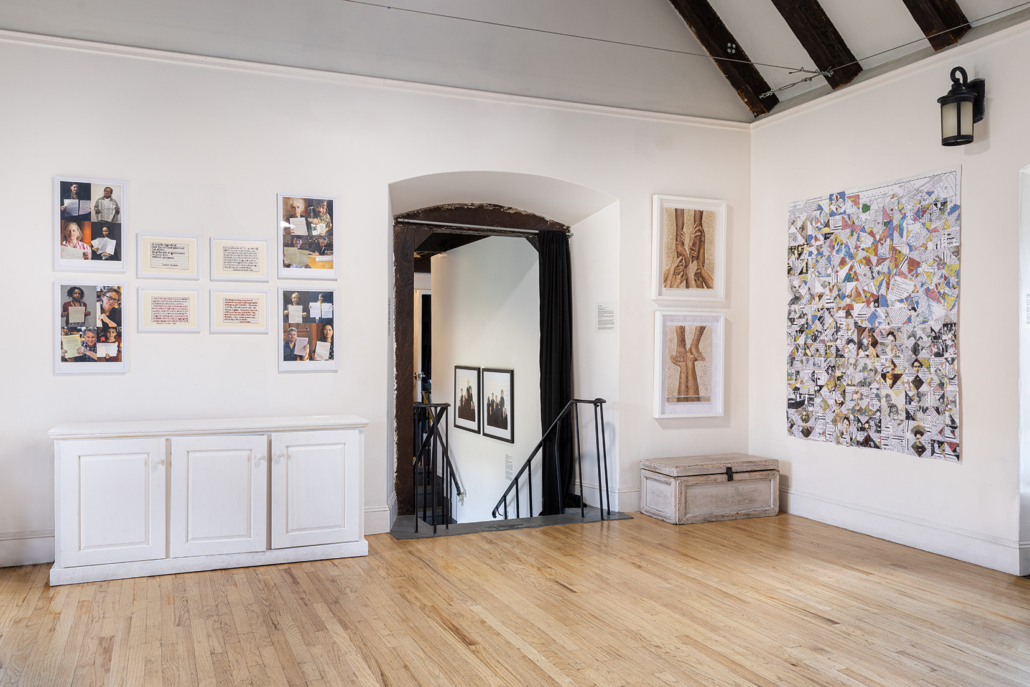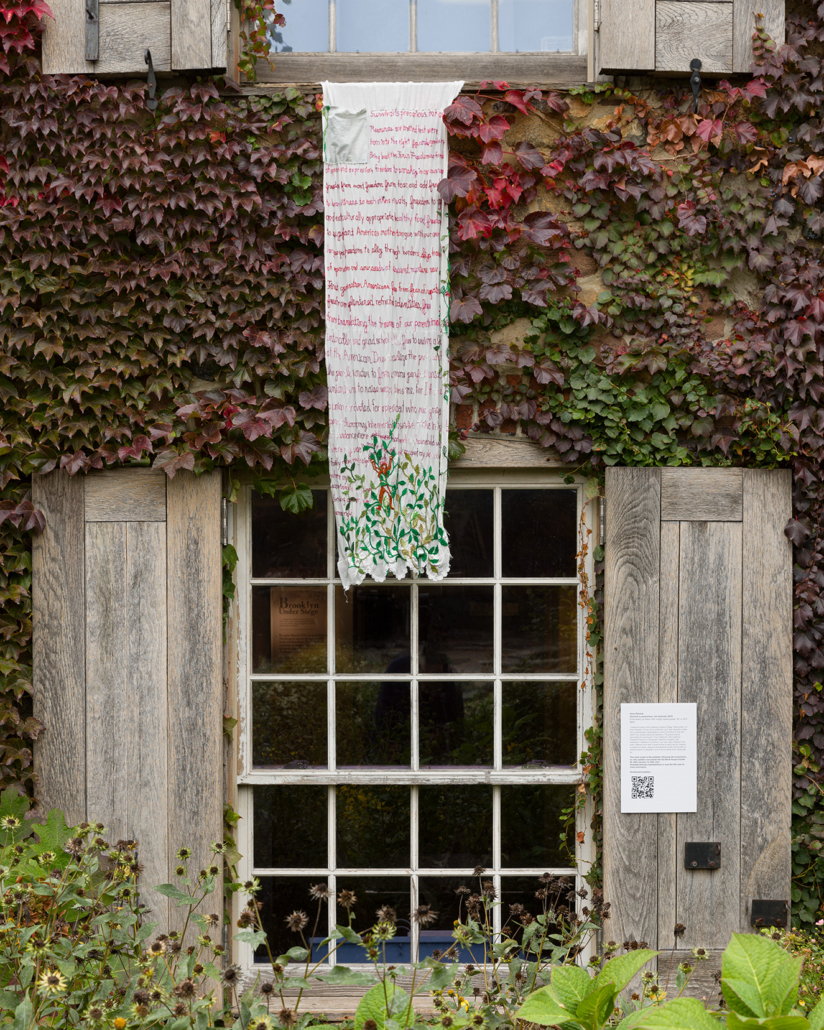This Exhibit is past. Visit our Exhibitions page for information on the current programming.
Picturing the Constitution
Katherine Gressel, Curator
October 20, 2023 – January 14, 2024
Opening Reception: October 22, 2023, 4:00 – 6:00 pm
Gallery hours Friday – Sunday, Noon – 4 pm
Picturing the Constitution features artists’ responses to the origins, contents, and interpretations of the United States Constitution. Projects in diverse media ask: to what extent do these founding documents still serve us (equitably)? What could we add or amend? At a critical time leading up to the 2024 presidential election, this exhibition examines the history and current state of democracy in America, our rights and responsibilities to our communities, and the role of artists in depicting and facilitating these ideals.
Central to the exhibition is the idea of the Constitution as inspirational yet incomplete and difficult to amend. Some artists respond to the current Supreme Court’s most consequential reinterpretations of Constitutional rights (such as the Dobbs v. Jackson Women’s Health Organization decision), or recent debates over citizenship, reproductive, gun, and voting legislation, with work that promotes both critical analysis and direct action. Some question the limits of American representative democracy. Some allude to alternative constitutions both real and imagined. Others draw from personal and communal histories to highlight populations historically excluded from constitutional protections (i.e. on the basis of race, gender, geography or immigration status), often as a result of constitutional “compromises” or omissions.
Most artists engage directly with specific texts, facilitating closer readings through isolating, combining, obfuscating, or illustrating key words or passages. Some focus on the Constitution’s idealistic intentions while grappling with such questions as, in the words of artist Maju Shandler, “As artists how do we create symbols that will inspire and enlighten” while still acknowledging “our nation’s complicated past and more pressing future?” Throughout the exhibition, patriotic and aspirational material is juxtaposed with questions about “the impossibility of freedom in a country founded on slavery and genocide,” to quote the title of a performance still by Dread Scott.
Multiple works in the exhibition incorporate the phrase “We the People” from the Constitution’s preamble, suggesting the power and responsibility of citizens to, in the words of artist Donna Bassin, “resist their own obliteration and insist on their full participation in democracy.” Several artists facilitate creative ways of rereading, revising or rewriting the document through both public performances/discussions and more intimate handwriting, crafting, letter writing and amending exercises.
Together, the artists in Picturing the Constitution emphasize the importance of deep engagement with the imperfect documents that have shaped our past and present, including imagining a more perfect future.
Participating Artists:
how to perform an abortion (Maureen Connor & Jason M. Leggett)
Dread Scott (Courtesy of the artist and Cristin Tierney Gallery, New York)
Enjoy this virtual tour slide show of the exhibition, photographed by Etienne Frossard.
Public Programs:
Saturday, October 21, 1-2pm: Ecofeminist Fashion Walk with Iviva Olenick
Sunday, October 29, 11am-3pm: Remedy for a Constitutional Crisis: Constitutional reading and discussion with Maya Ciarrocchi outdoors in the North Garden (rain date November 4).
Friday, November 10, 7:00pm: Aftermath: A New Musical. Aftermath is new pop musical that follows the aftermath of a school shooting. This work-in-progress-sharing will include a talk back and an opportunity to engage with the writers, director, plus artist Ileana Doble Hernandez and her installation: “Postcards for Gun Control (Mommy, what is this?)”.
Monday, November 13, 6:30-9:30pm: Handwriting the Constitution session with Morgan O’Hara
Sunday, December 3, 1-3pm, Penumbra Kit: a workshop on reproductive rights and the Constitution, presented by artist Maureen Connor (of how to perform an abortion) and legal scholar and educator Jason M. Leggett.
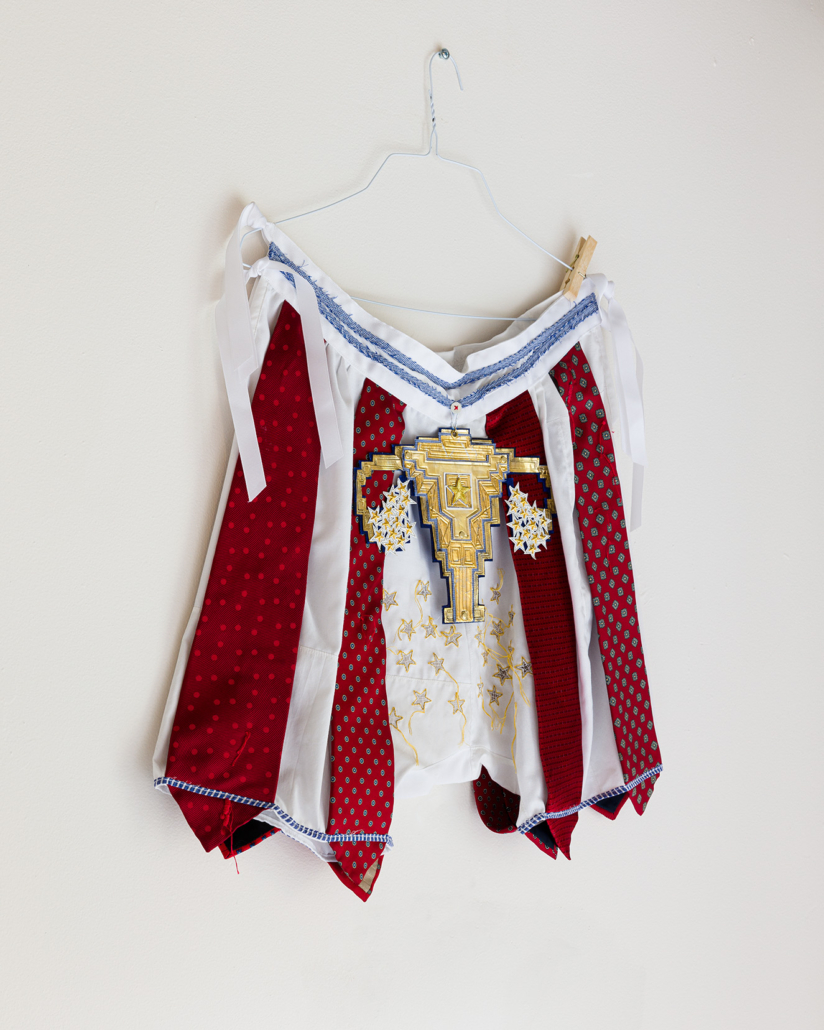
Winnie van der Rijn
As My Rights Are Washed Away/My Body Is A Sovereign Nation (Uterine Armor 10), 2023
Repurposed menswear, metal, water soluble substrate, 29” x 28” (with hanger)
Like the Old Stone House, my work is both revolutionary and domestic. This project merges my practices of making American flags and armor. I am constantly trying to reconcile my leftist Berkeley education and deeply feminist outlook with my military upbringing. I have long struggled with ideas of patriotism and allegiance and believe we should continuously reassess our allegiances and the symbols that bind us together. As I read the founding documents, I got stuck on the word Liberty. It kept echoing, resonating. As used in the Constitution, liberty means freedom from arbitrary and unreasonable restraint upon an individual. Freedom from restraint refers to more than just physical restraint; it is also the freedom to act according to one’s own will. Liberty is what I expect. Liberty is what I demand. I can’t get past the Dobbs decision. It motivated me to start making uterine armor for our daughters and granddaughters and friends and nieces. We must be battle ready. We cannot allow our rights to be washed away.
This pair of bloomers made from repurposed men’s shirts with a detachable uterus resembles the American flag. Stars representing the states that are taking away abortion rights were made of water soluble substrate and dissolved leaving ghost stars.
Photographed by Etienne Frossard.
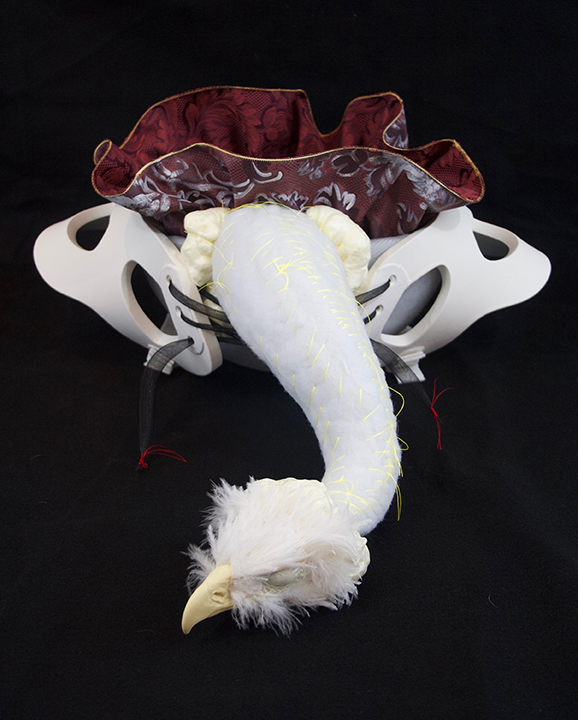
Manju Shandler
Sleeping Eagle 1, 2018
Mixed media, 26” x 20” x 8”
As citizens, how do we unpack our nation’s complicated past and more pressing future without becoming uprooted from our foundational ideals of Liberty, Justice, Freedom, and Equality for all? As artists, how do we create symbols that will inspire and enlighten?
Sleeping Eagles is a series of sculptures exploring the fable of nationalism. The female form of these eagles, apparent in their decorative, vessel-like bodies, is surrounded by net and armor, mixing the vulnerable with the fierce. Raptors are usually thought of as hunters, alert and masculine. These eagles are caught napping, their power apparent, but also inactive. Female eagles are the larger of the two sexes, with a wider wingspan and up to twice as heavy. In this moment of female empowerment, as we are awakening, what goals will the sleeping eagles rise and focus on?
Image courtesy of the artist.
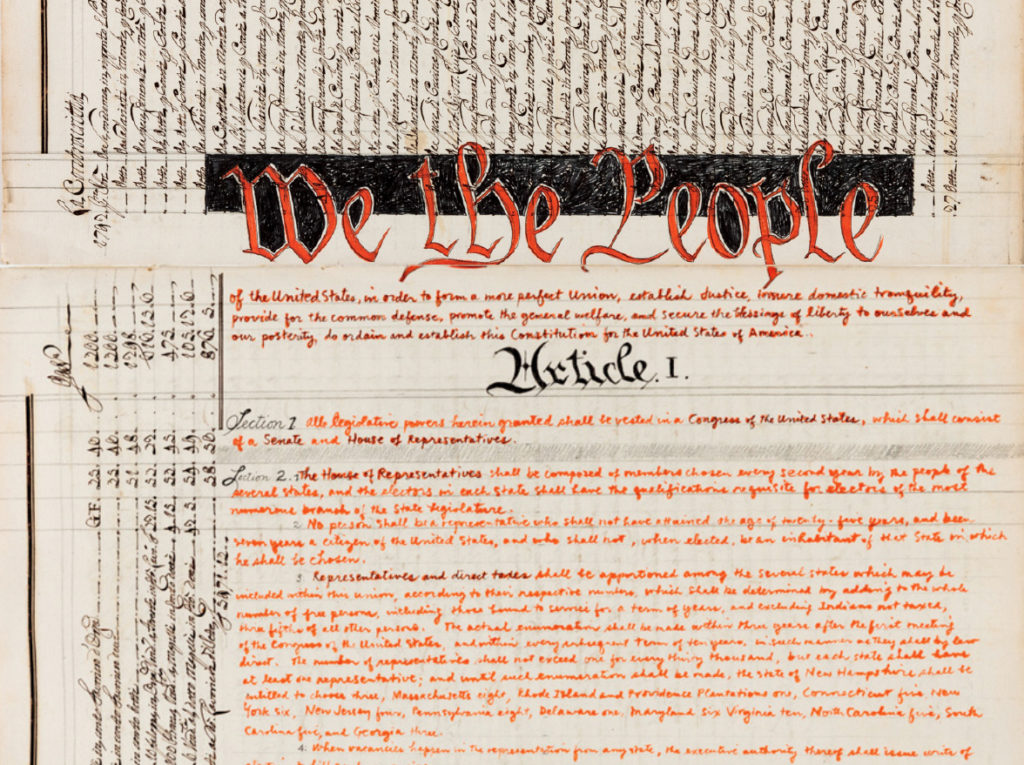
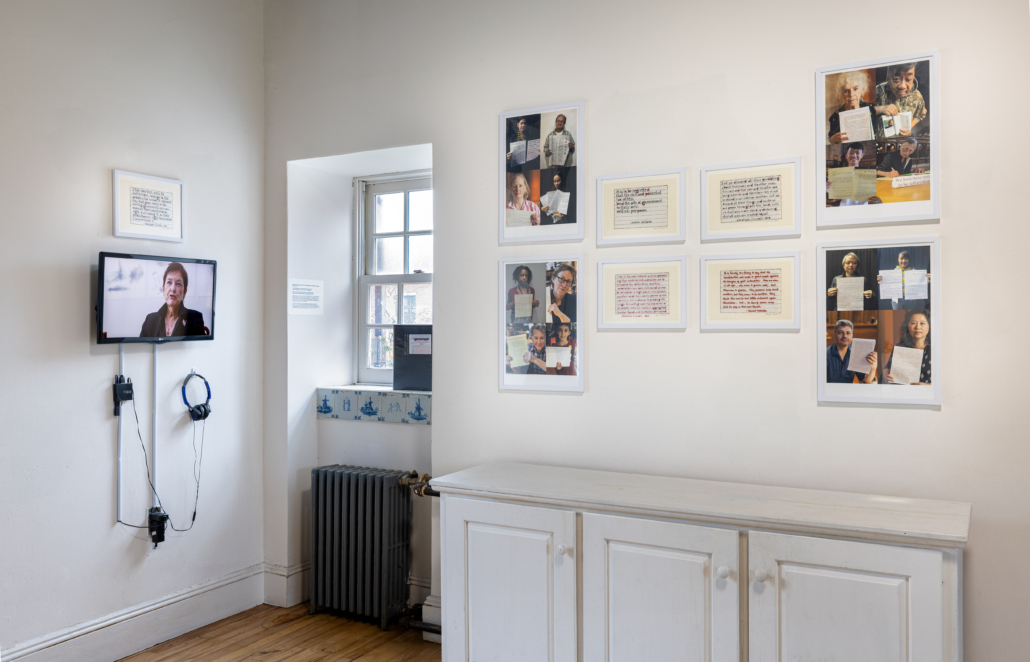
Top Image:
Morgan O’Hara, selections from Handwriting the Constitution project, 2017
Ink on handmade Italian paper, 24” x 30” framed
Middle Image:
Far Left: Morgan O’Hara, quote from Abraham Lincoln,
Ink on rice paper, 7.5” x 10.5” (9” x 12” framed)
Left and Right: Photographs from past Handwriting the Constitution workshops, 2018—present
Digital prints, 13” x 19”
Center: quotes from Abraham Lincoln, Andrew Jackson, and Daniel Webster
Ink on rice paper, 7.5” x 10.5” (9” x 12” framed)
Video:
Bill Antonucci, Duke Street Films
Documentary: Handwriting the Constitution, 2019 7:41
Handwriting the Constitution is a social art project I began in 2017. It invites people from all walks of life to meet in public spaces to handwrite the U.S. Constitution or other documents written to protect human rights and freedoms. This art practice was created so that people will know their rights, deepen their understanding of laws created to protect these rights, and to help resist negative thinking. To date over 2000 people have participated, both nationally and internationally.
The goal of this art practice is to encourage people to hold their own Handwriting sessions on a recurring basis, to create a physical and psychological space that explores the practice of concentrated writing as an art form, and a process designed to bring people together in a quiet and calming way, all by focusing on human rights. It has been identified as a powerful and transformative form of activism for introverts.
This selection of photographs includes images from workshops all over the world in which participants hand wrote various international Constitutions as well as the Universal Declaration of Human Rights. Documents are selected because of their focus on human rights and freedoms. The people who attend the sessions choose whichever documents they wish to copy. Many of these documents are much lengthier and detailed than the U.S. Constitution and provide an interesting point of comparison.
This social art project does not exist as a political tool nor is it meant to create a political group. There is no requirement for any individual to state a political affiliation. In fact, little extended dialogue occurs between participants other than a welcome and help in getting started. Anyone can set up a session to handwrite documents created to protect human rights, in any language, anywhere in the world.
Click here for more information about the Handwriting the Constitution project.
Center photo by Etienne Frossard.
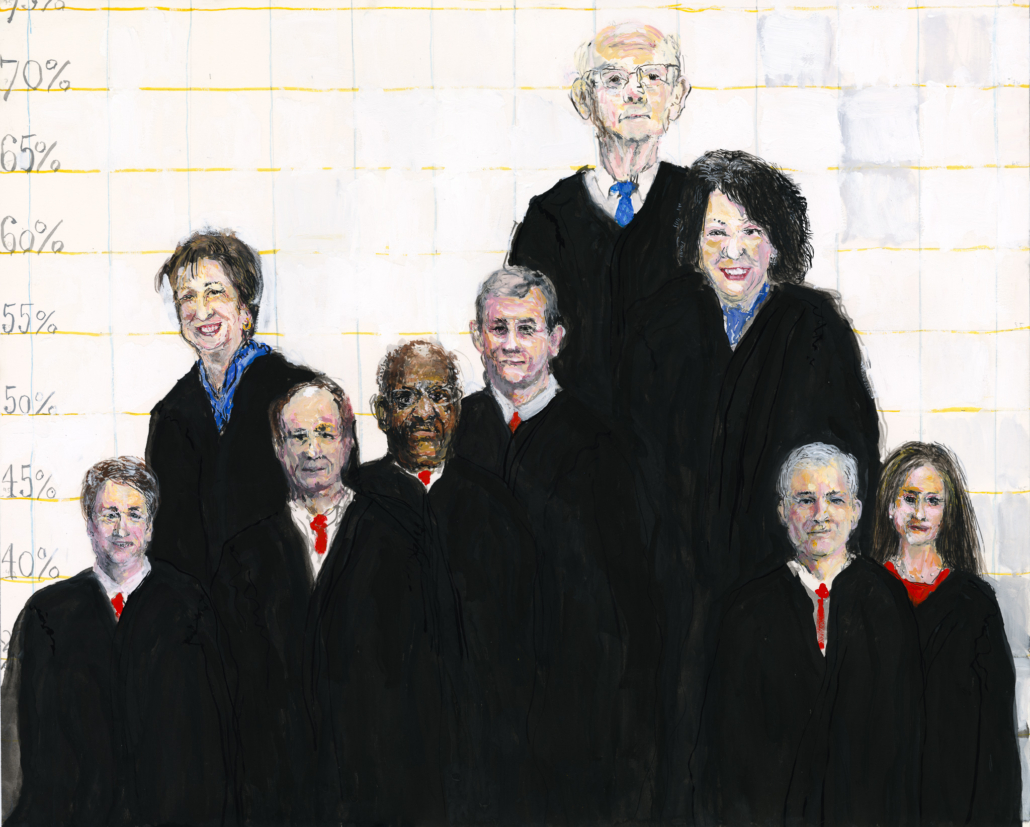
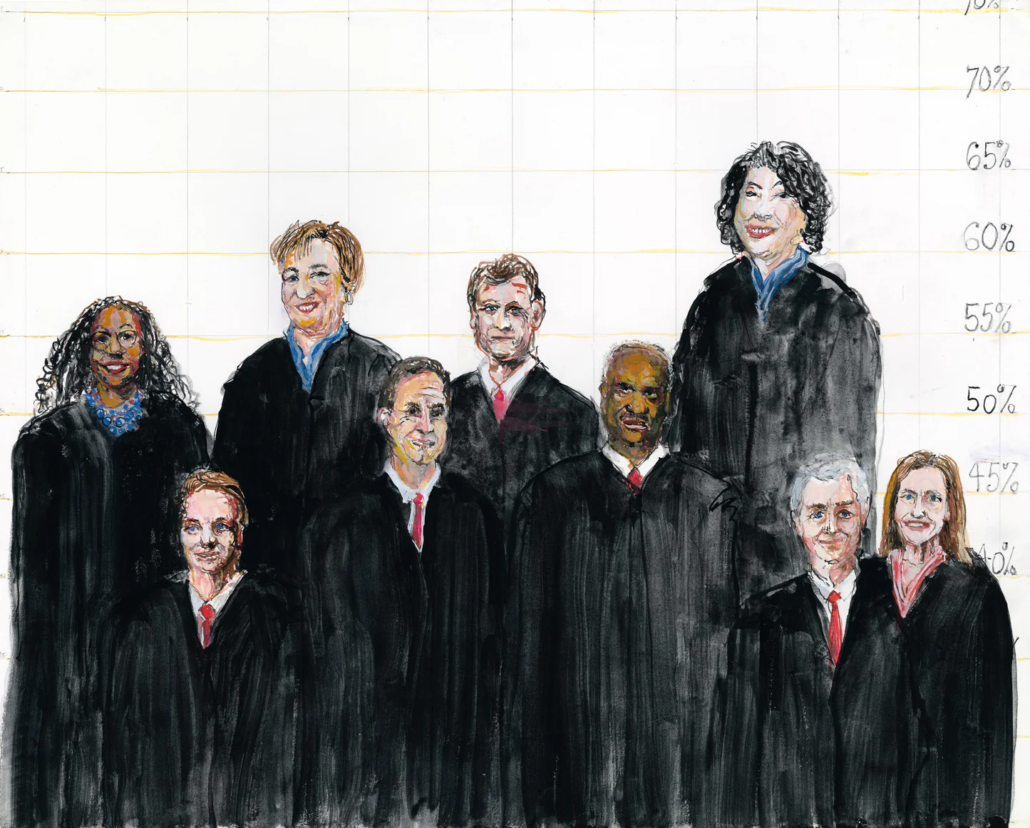
Michael James Freedman
Top: The Mismeasure of Justice: What a Truly Representative Supreme Court Would Look Like (2018)
Bottom: The Mismeasure of Justice: What a Truly Representative Supreme Court Would Look Like (2023)
Gouache on Paper, 20” x 16” (24” x 28” framed)
The Mismeasure of Justice
I made the first of these paintings in 2018, when I was obsessing over politics and disturbed that while the Supreme Court makes judgements that affect all of us, the Court is not representative of the majority. I made the second this year, after the confirmation of Justice Kentaji Brown Jackson.
Each Justice’s Height is Tied to the Popular Vote of The Elected Representatives that Chose Them
The height of each justice is determined by roughly how representative their selection was. I use a formula that compares each justice based on what percentage of the U.S. voted in favor of the president that appointed them and the number of senators that voted to confirm them. In the 2018 court, Stephen Breyer towers over the rest of the justices since he was nominated by a president (Bill Clinton) that won the popular vote and was confirmed by a vote of 87 to 9 in the Senate. On the other hand, Brett Kavanaugh was nominated by a president (Donald Trump) who lost the popular vote, and was confirmed in a very close vote. In addition, the states whose senators voted for Kavanaugh had smaller populations, representing only 44% of the population of the United States.
Each Justice is Wearing a Color to Indicate Party
Blue represents a Justice nominated by a Democratic president; red, one nominated by a Republican. The Republicans are shorter than the Democrats because the Republican presidents have typically either lost the popular vote (Trump) or won it by a small margin (George W. Bush in his second term). In addition, the average state that Republicans represent (e.g. the Dakotas) have smaller populations than the average state that Democrats represent (e.g. California or New York).Some things change, some things stay the same.
One theory is that back in the day, the Senate was less contentious and that is why Breyer is such an outlier. But if we look back (Clarence Thomas who was chosen before Breyer) or forward (all of the Trump nominees), we see that in fact the Republican nominees are often supported by slimmer majorities of senators and that those senators are from smaller states. So in the 2023 court, while nobody towers over the court like Breyer, the blue justices are still taller than the red ones. And Katanji Brown Jackson, chosen just this year, is taller than all but one of the Republican appointees.
Images courtesy of the artist.
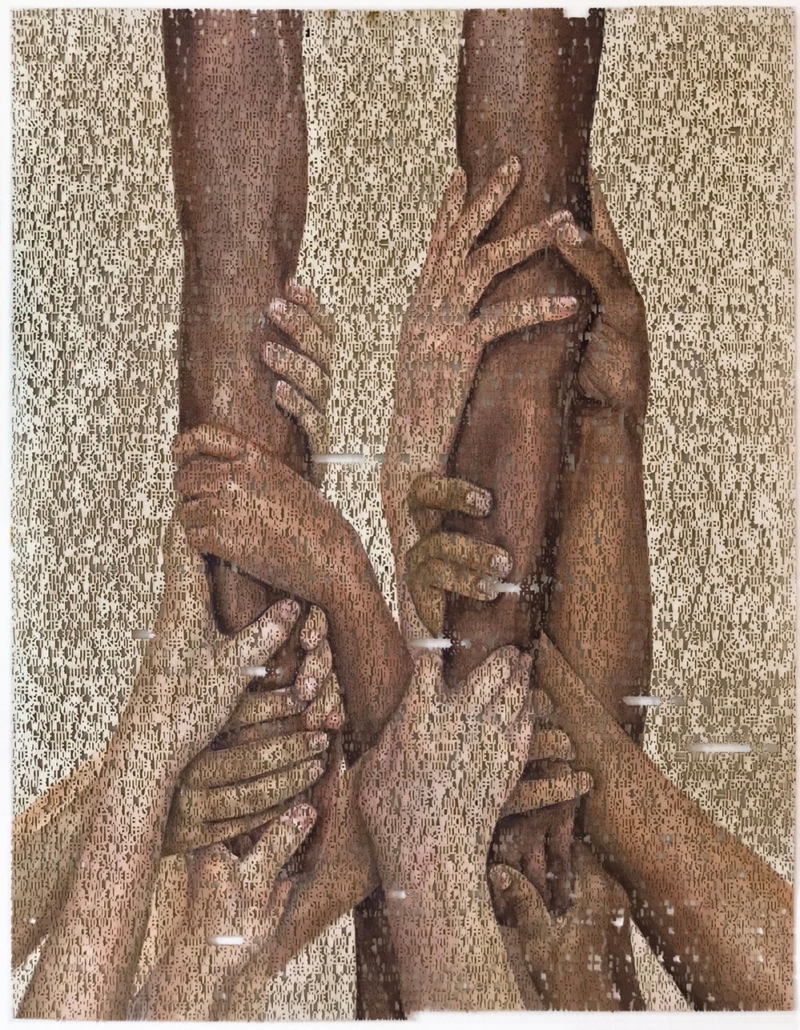
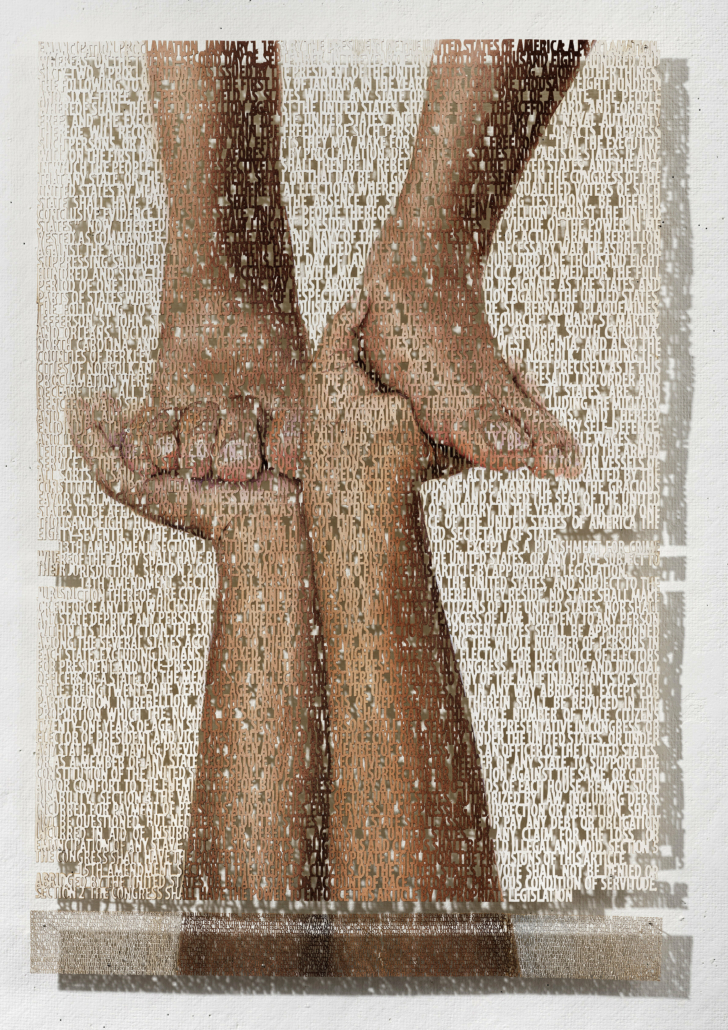
Diana Schmertz
Top: Title IX, 2018
Laser cut watercolor painting on paper, 22.5” x 17”
Bottom: Reconstruction, 2021
Laser cut watercolor painting on paper, 21.5” x 14.5”
I create work that emphasizes inclusion and the importance of positive social agreements. I research public and legal documents that support ideas of egalitarianism and empowerment. I laser cut the document text into each painting. By using two strongly contrasting techniques, handmade and machine made, the physical work reinforces the conceptual idea that sensory/emotive understanding is fundamentally connected with analytical logic.
Title IX has a visual depiction of the words in Title IX of the Education Acts of 1972 (intended to protect students from discrimination based on sex) by showing a woman pulling up a group of girls. This is an expression of how education plays an integral role in the advancement of women in America and is one of the greatest equalizers of humanity in any culture.
Reconstruction is part of a series titled Citizen, a timeline of the history of people’s rights in America starting with the Declaration of Independence. The imagery of people holding up children demonstrates humanity’s ability to make things better for future generations. Reconstruction contains texts from the Emancipation Proclamation, the 13th – 15th amendments, and the 1896 Supreme Court case Plessy vs. Ferguson laser cut throughout the painting. This image and most of the text allude to the gigantic leap for our country and the betterment of our Constitution (with amendments that abolished slavery and established citizenship and voting rights). The SCOTUS case text is quite small, acting as a footnote that acknowledges how states still held back progress with separate but equal laws upheld by the Court.
My main objective is for people to question the social agreements in which they both voluntarily and unintentionally engage within our society. At first, most viewers tend to respond to the emotion in the paintings. Upon closer view they start to see and read the text. By using text and emotional imagery I invite viewers to take part in the conversation through whichever mode of communication they feel most comfortable.
Images courtesy of the artist.
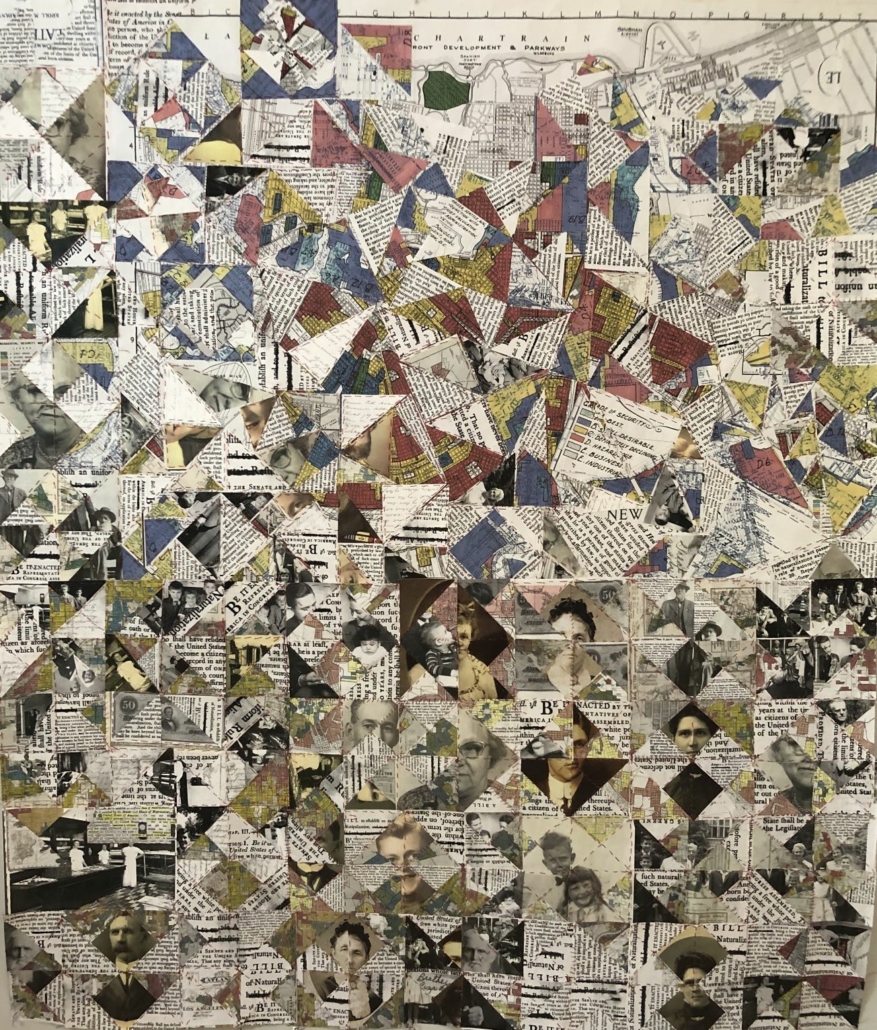
Kim Rice
Inheritance, 2019
Hand sewn redlining maps, photographs of ancestors, Naturalization act, 60” x 60”
Like many Americans I was taught the story of the United States growing up—great founding fathers, equality for all, and hard work creates wealth—the American Dream. And while there is some truth to this narrative, it left out a large part of history, creating a disconnect in the America I experienced as a young adult. By researching the construction of race in America and my family lineage, the divisions and inconsistencies I experienced began to make sense. To have a just and equitable country for all people we must first understand our history.
My work dismantles and reconstructs the dissonance we experience in our engagement with truth. Academic references, photographs, maps, court documents, magazines and building materials create a space where both the past and present reside. Woven, sewn, and linked together, my work repeats pieces of truth over and over so connections can be made and intentional conversations started.
For Inheritance, I hand cut and sewed a familial quilt using redlining maps, the Naturalization Act of 1790, and images of my ancestors.
Redlining maps were created In the 1930s by the U.S. Government. They provided low interest mortgages through the Home Owners Loan Corporation. Only areas that were considered white (at that time) had access to these mortgages. This practice was legal until 1968.
The Naturalization Act of 1790 stated you must be ” a free white person… a person of good character” to become a citizen of the United States. This institutional racism benefited my family and its residue continues to help some communities thrive while others suffer.
Image courtesy of the artist.
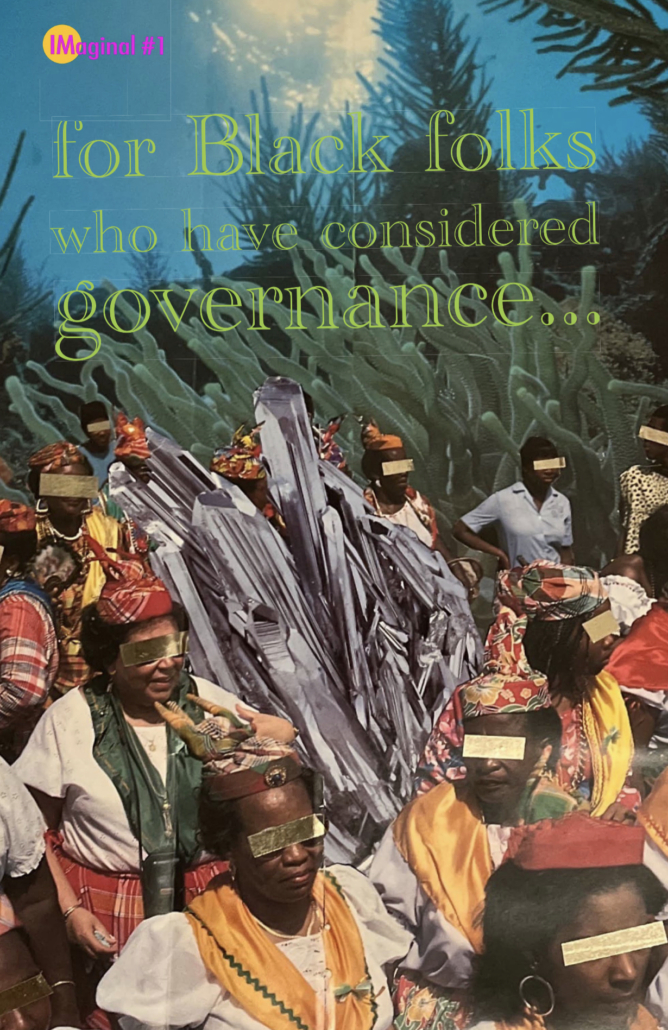
Aisha Shillingford / Intelligent Mischief
for Black folks who have considered governance…
(1 of 5; 2 of 5; 3 of 5; 4 of 5; 5 of 5)
October, 2023
Zine, mixed media collage print
8.5″ x 5.5″
$25
What must exist for us to heal from our collective historical trauma and re-imagine governance grounded in love for Black and Indigenous people? Can we expand our view of the purpose and forms of governance? Can we access alternative ways of knowing to shape our collective commitments, our rights and responsibilities, our shared contributions to a multi-racial, inclusive democracy? How do we unleash our imaginations to shape our personal and collective transformation? This zine is not intended to directly answer these questions. Rather, these are among the questions we need to hold, each of us, for ourselves and then hold collectively as we navigate the transitions of our time.
And of course, that’s what we’re always about at Intelligent Mischief. Creating spaces where Black folks can collectively imagine and co-create beautiful futures.
Image courtesy of the artist.
View the full zine here on Intelligent Mischief‘s website.
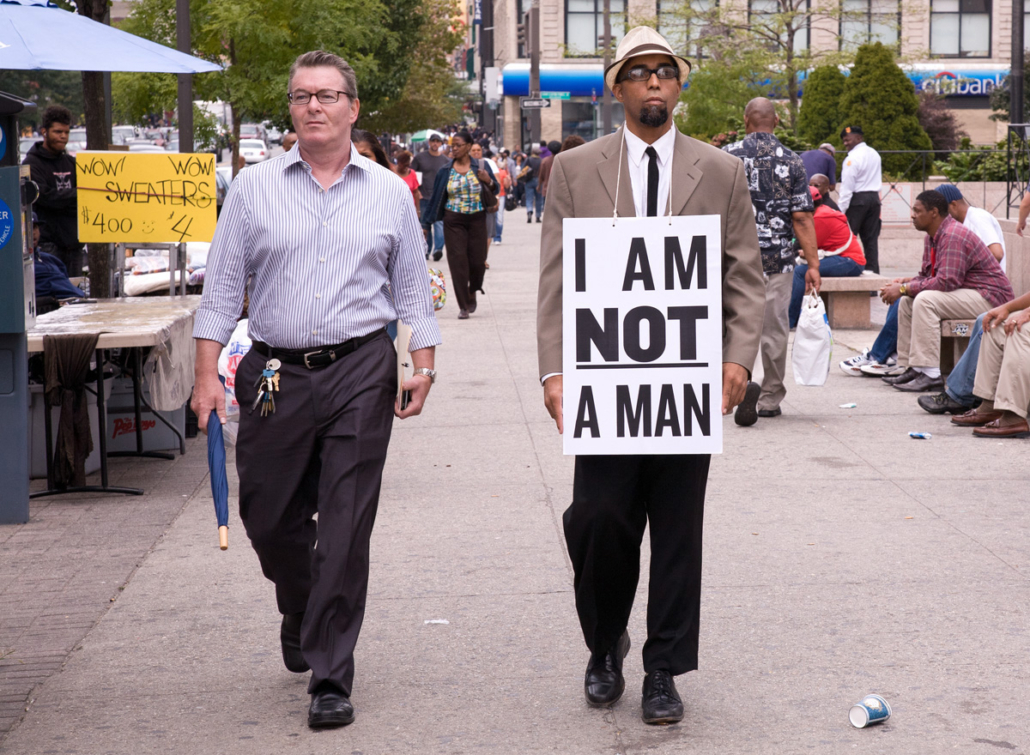
Dread Scott
I Am Not A Man, 2009
Pigment print, 22” x 30”
Edition 1 of 5
Courtesy of the artist and Cristin Tierney Gallery, New York
I Am Not a Man was an hour-long performance that was presented on the streets of Harlem, New York on September 9, 2009. I walked bearing a historic, but crucially altered, protest sign that read “I Am Not a Man.” Throughout the walk, actions in the performance evoked the humiliation that is visited on Black people and the negation that defines our existence.
Making reference to the 1968 Memphis Sanitation workers strike where the iconic “I Am a Man” sign originated, the performance inverted the sign’s statement, pointing to the importance of the Civil Rights protests as well as to their limitations. Along with this historic resonance, the performance simultaneously addressed our era—racism is foundational to America and has not abated. Despite assertions that America has entered a post-racial period, reality contradicts this: 1 in 9 young Black men are in prison; predatory lending policies have caused the greatest loss of wealth for people of color in modern U.S. history, etc.
I Am Not a Man resides in the uncomfortable space between a race-free fantasy world and the lived experience of millions.
This performance was made possible, in part, by the Franklin Furnace Fund and supported by Stimulus funds from the New York State Council on the Arts, a state agency; the Lambent Foundation; and Jerome Foundation.
Image courtesy the artist and Cristin Tierney Gallery, New York.
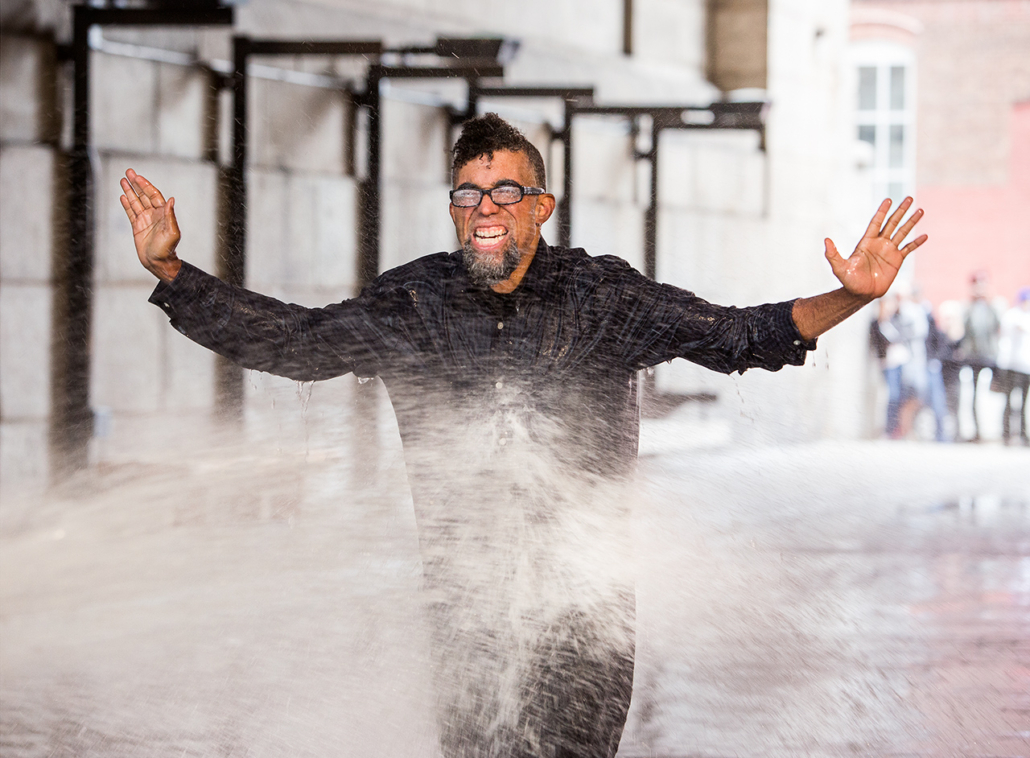
Dread Scott
On the Impossibility of Freedom in a Country Founded on Slavery and Genocide, 2014
Pigment print, 22” x 30”
Edition 1 of 5
Courtesy the artist and Cristin Tierney Gallery, New York
On the Impossibility of Freedom in a Country Founded on Slavery and Genocide (2014) is a performance about the struggle for freedom. People yearn for freedom and have repeatedly struggled against oppressive governments, economic, political and social relations. People have taken great risks in a struggle for emancipation and have often been battered in the process. This performance referenced the 1963 Civil Rights struggle in Birmingham Alabama in which the government used high-pressure water jets from fire hoses against non-violent protesters and bystanders in an effort to maintain segregation and legalized discrimination. In the performance, I made a Sisyphean attempt to walk forward while repeatedly battered and occasionally knocked down by a water jet from a fire hose. The performance references this history as a metaphor for a larger struggle for freedom and had inescapable references to present day struggles against racism, most recently witnessed on the streets of Ferguson, MO in response to the police murder of Michael Brown.
Project produced by More Art.
Image courtesy the artist and Cristin Tierney Gallery, New York.
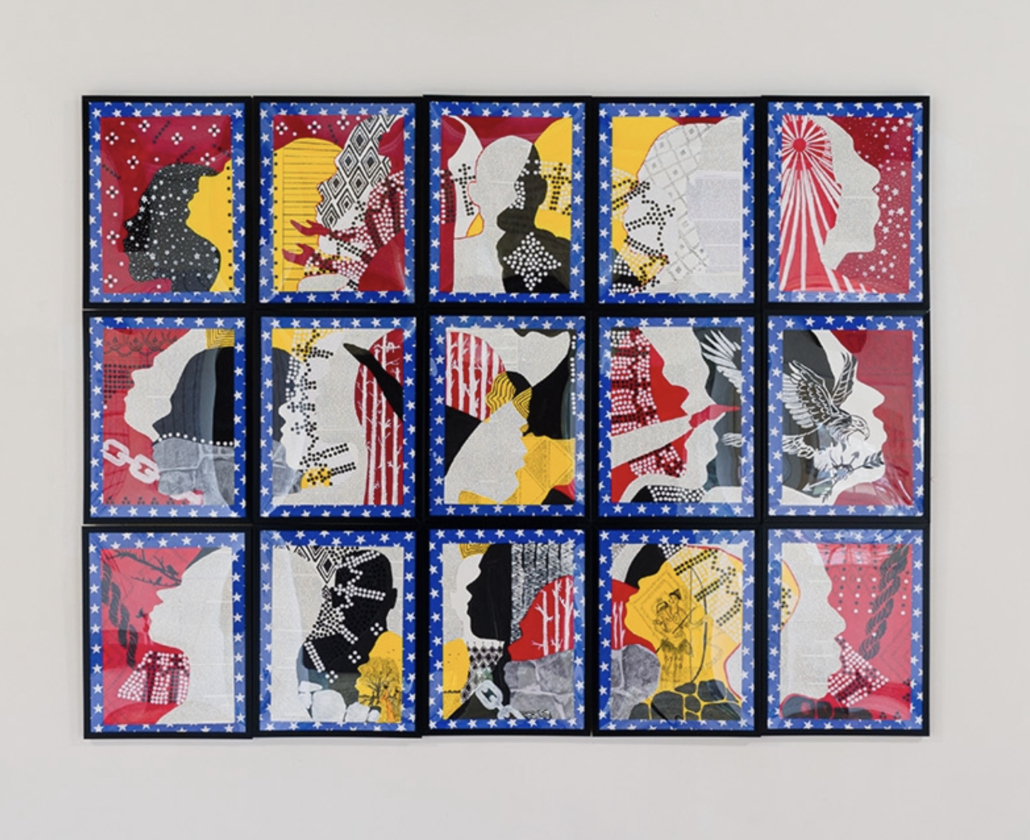
Dennis RedMoon Darkeem
Legacy of the Land: Unveiling the Indigenous Influence, 2023
Painting and collage on paper, 48” x 60”
This work reflects on Indigenous influence on American government and the complex legacy of James Madison. It was inspired by a visit to Madison’s Montpelier estate in Orange, Virginia during a local artist residency. The estate has since become a museum and a place of historical significance. This artwork serves as a stark reminder of the labor that sustained such grandeur, with more than 500 enslaved individuals toiling on the property and thousands more sent across states for various laborious tasks. Through a fusion of Civil Rights imagery and excerpts from James Madison’s writings, it underscores the often-overlooked contributions of Indigenous and Black communities in shaping the Constitution. Four colors, representing the medicine wheel (an ancient and sacred symbol used by many tribes) serve as a visual tribute to humanity, the changing seasons, the elemental connection to the land and the four cardinal directions.
Historic background
James Madison, the fourth President of the United States and often referred to as the “Father of the Constitution,” played a pivotal role in shaping the nation’s foundational document. Alongside Alexander Hamilton and John Jay, he authored The Federalist Papers, advocating for the Constitution’s ratification. My artwork delves beyond the conventional narrative, shedding light on how Madison’s vision of a powerful federal government echoed imperialist ambitions reminiscent of the Roman Empire. This perspective raises important questions about the treatment of Indigenous peoples and their ancestral lands in the context of the Constitution.
I also explore the influence of the Iroquois Confederacy, composed of the Mohawk, Onondaga, Oneida, Cayuga, Seneca and Tuscarora nations, on the Constitution’s framing. This influence even extends to the adoption of the bald eagle as a national symbol. The Iroquois Constitution, known as the Great Law of Peace, provided a framework for governance including a model of federalism. It was finally formally recognized for its contributions by a 1988 Senate resolution. This ancient constitution, dating back to 1450, organized Iroquois society and emphasized principles of unity and sustainability epitomized in the Seventh Generation Principle where the decisions made at any given time should result in a sustainable world seven generations into the future.
Additionally, my work references the Constitution’s treatment of slavery. The original document contained provisions that acknowledged enslaved individuals as “other persons” and established the infamous Three-Fifths Compromise which counted three out of every five slaves for representation and taxation.
I hope that my work challenges us to reevaluate the roots of the Constitution and its complex relationship with Indigenous and African American communities while contemplating the path to a more equitable future.
Photographed by Etienne Frossard.
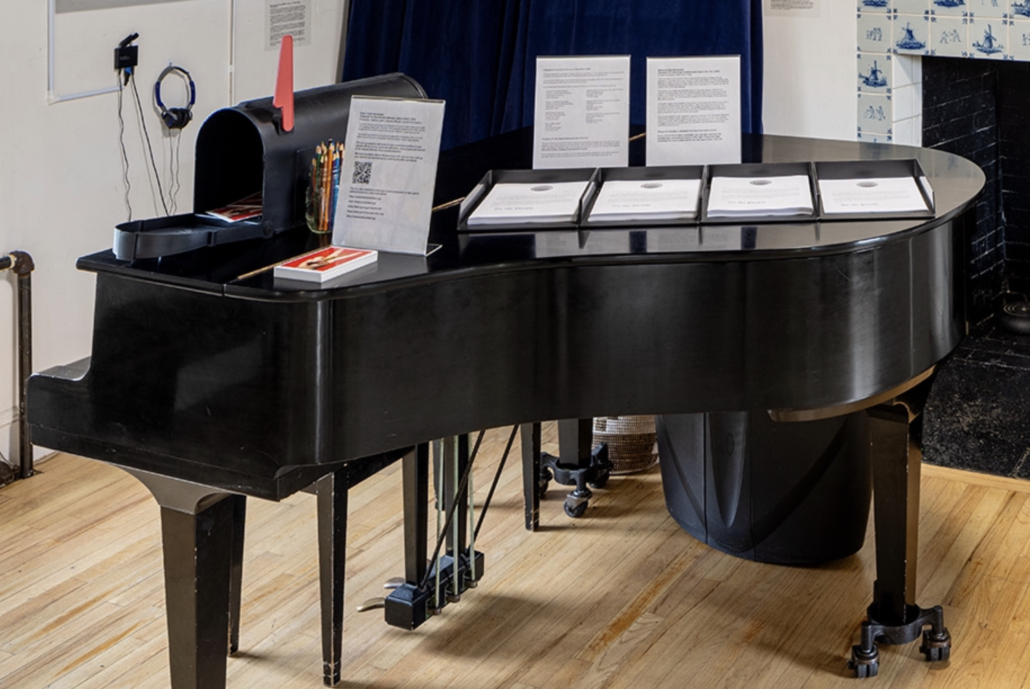

Ileana Doble Hernandez
Postcards for Gun Control (Mommy, what is this?), 2018
Postcards, mailbox, pens, elected officials’ contact information
The front of the postcard shows a photograph of my son’s hand holding a toy bullet while making a peace sign. The back of the postcard contains a short letter with the phrase “No more children should die from gun violence. I support gun control.”
This project was inspired by my personal experience immigrating to the U.S. from Mexico around the time of the Sandy Hook Elementary School mass shooting.
Fill out a postcard to advocate for gun control by sending it to an elected official. At the end of the exhibition, all postcards will be sent to the elected officials these are addressed to.
We have provided a list of officials local to NY, but you may look up your specific representatives by clicking here.
You may also research current gun control proposals, or take part in additional actions, at the links below:
https://www.gaysagainstguns.net/
https://www.gunviolencearchive.org/
Photographed by Etienne Frossard. Postcard image courtesy of the artist.
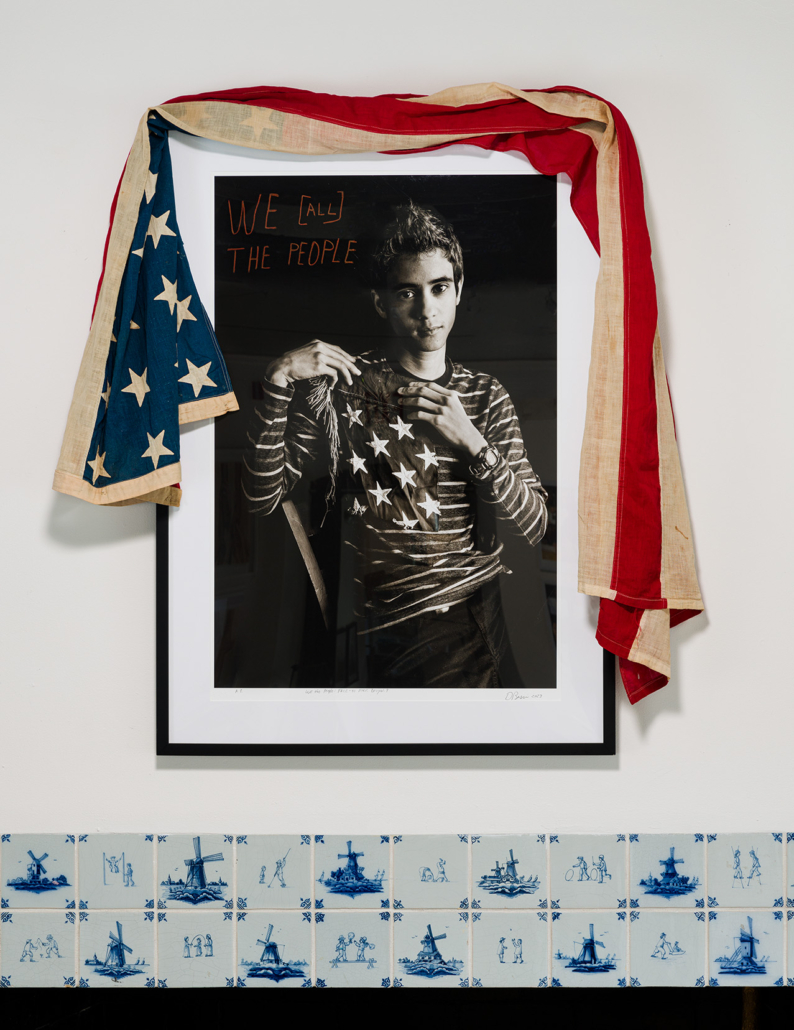
Donna Bassin
We the People: FACE-to-FACE.Devyn.9
Archival pigment print; repurposed American flag, 31” x 43”
“My name is Devyn and I am a Latino trans man living my truth. I am proud of my gender identity and am grateful for all the amazing and supportive people I’ve met and been able to work with because of my visibility. I choose to be visible for various reasons, one of the main reasons being that I want other trans folks, especially trans youth, who are struggling with their gender identity to know that they are not alone and can be their true selves – even though our current political climate is trying to take away our basic human rights and protections. I want America to see that we are all just human beings and deserve to be treated with the same kindness and respect as our fellow straight cis humans.” ~ Devyn Nunez
“We the People: FACE-to-FACE is an invitation for the viewer to encounter and engage with an ongoing portrait project, My Own Witness, which began in response to the aftermath of the 2016 presidential election when the limited effectiveness of the Constitution became more visible. I asked my portrait sitters to turn themselves ‘inside out ‘ and to use pose, gesture, gaze, and props, such as the American flag, to represent their own experiences of the current crisis of democracy and constitutional law. While the American flag has become a complicated symbol, most of my sitters reclaimed and reimagined it to express their distress, defiance, and/or respectful hope for genuine democracy and liberty.” ~ Donna Bassin
Photographed by Etienne Frossard.
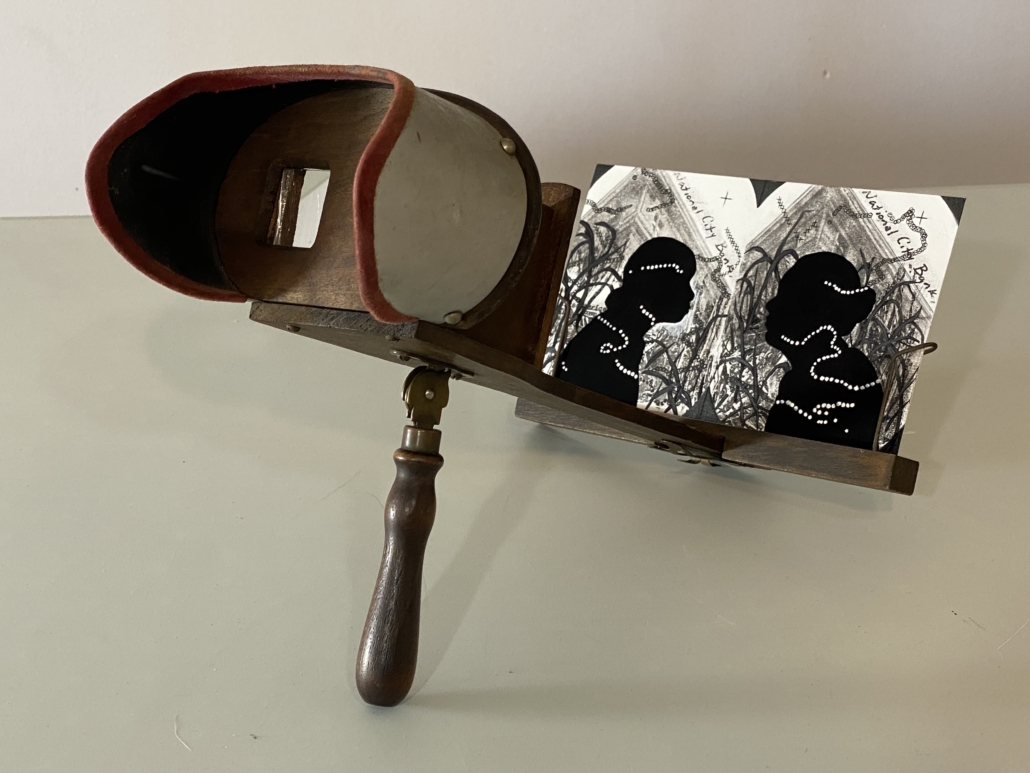
Alex Callender
A case of memory, whether the sugars were never ours, 2023
Mixed media drawings and wood stereoscopes, each 12″ x 12″ x 15″
Thinking metaphorically about sightlines and borders, this series of drawings viewed through stereoscopic frames combines archival documents with early 20th century American foreign policy narratives in the Caribbean, remixed with economic and social histories enabled by the 1901 Insular Cases.
The Insular Cases are a series of Supreme Court decisions regarding the status of U.S. territories acquired during the Spanish–American War that still govern these territories today. They are widely considered racist in their language and intent, creating unequal access to citizenship, mobility, land, labor rights, economic sovereignty and ecological justice in the hemispheric divide of the Americas. Residents of unincorporated territories (those not on a path to statehood) including Puerto Rico, the Philippines and Guam have not been given full constitutional protections. While the cases themselves were meant to consolidate questions of US extra-legal constitutional power in these newly acquired territories, the history of intertwining American corporate and banking interests in Cuba, Panama, Haiti and the Dominican Republic tell an adjacent narrative of how economic power shaped border relationships between the US and the Caribbean in the early 20th century. The Insular Cases affected how we think of U.S. citizenship and border politics in the age of American economic imperialism and the reimagining of manifest destiny in the 20th century. Today, many legal scholars refer to the Insular Cases as a constitutional justification for colonialism outside United States boundaries.
Stereoscopic frames are a 19th-20th century tool of sight and illusion. They were often a means to circulate tourist trading cards as a way of making “far off” places come to life. These drawings ask viewers to think about how power is revealed or disassembled through constitutional narratives and artifacts of American imperialism.
Click here read the related Supreme Court decision: U.S. Supreme Court, DeLima v. Bidwell, 182 U.S. 1 (1901) No. 966. Argued January 8-11, 1901. Decided May 27, 1901.
Image courtesy of the artist.
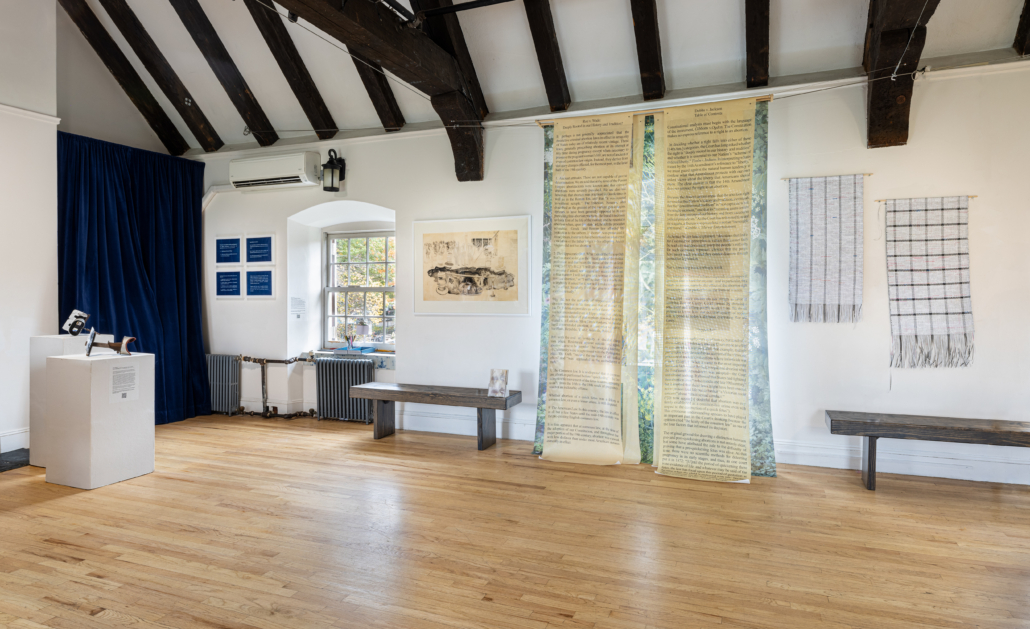
Maya Ciarrocchi
28th Amendment prints, 2023
Top row, L-R: Amendment 1, Amendment 2
Bottom row, L-R: Amendment 3, Amendment 4
Cyanotypes on paper, 11” x 14”
From Remedy for a Constitutional Crisis, a durational reading of the U.S. Constitution by multiple performers in multiple languages
Remedy for a Constitutional Crisis is an ongoing project conceived in response to the 2016 election and inspired by Burt Neuborne’s book Madison’s Music. Neuborne, a Professor of Civil Liberties at NYU Law School, states that the First Amendment can be read as poetry, and he challenges the literal or originalist interpretation of the document.
Remedy for a Constitutional Crisis comprises a durational performance of the U.S. Constitution by multiple performers in multiple languages; facilitated long table discussions on topics such as the separation of powers, Federalism, and individual rights; and areas where attendees write their own amendments or modify existing ones. Remedy for a Constitutional Crisis was presented at Abrons Art Center in 2017 and Smack Mellon in 2020.
The cyanotypes of four proposed Amendments to the US Constitution exhibited here are just some of the participatory writings gathered during the above iterations. The authors chose to remain anonymous.
Remedy for a Constitutional Crisis will be performed outside the Old Stone House on Sunday, October 29, 2023 (rain date Saturday, November 4, 2023) from 11am – 3pm.
Use the index cards provided to write your own 28th Amendment and leave it in the tray!
To see Remedy for a Constitutional Crisis performed at Abrons Art Center, click here.
Photographed by Etienne Frossard.
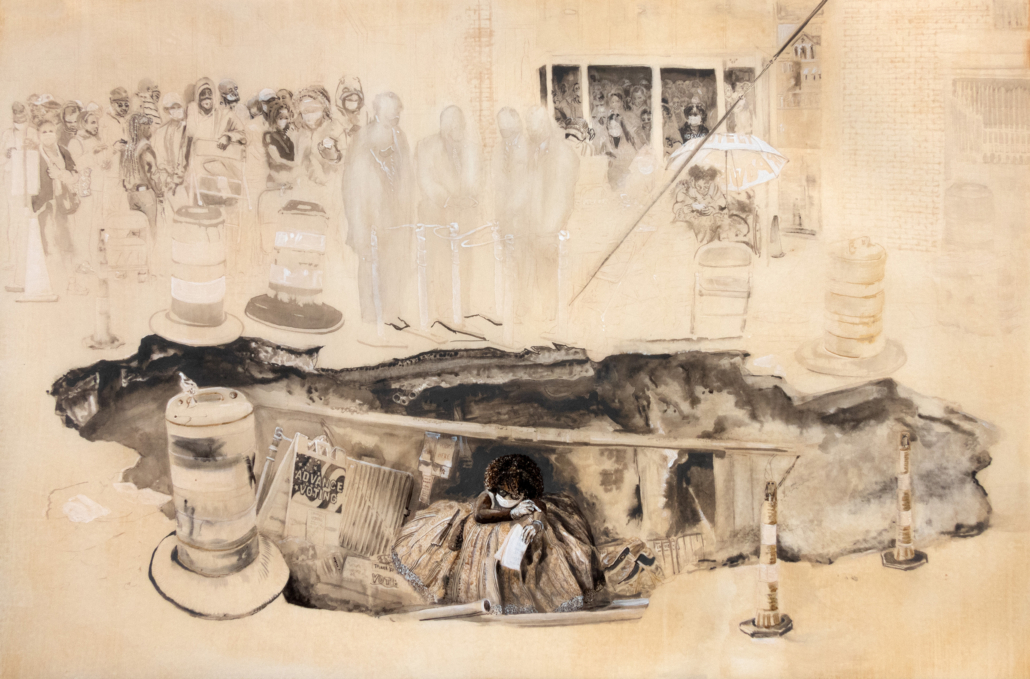
Andrew Ellis Johnson
Sinkhole, 2023
Medium ink and gouache on paper, 37.5” x 24.5” (43.5” x 31.5” framed)
There has always been a gap in the Constitution—between its ideals and the realities by which this country has been governed. At times, the gaps are horrific chasms; sometimes they begin to close, promising rights more equally distributed. My allegorical visual narratives explore the profound consequences of a constitution written by white men, the majority of them owners of enslaved people. They address ways that the ideals of the Constitution have been selectively applied or ignored, leaving many outside its stated principles and protections, particularly concerning voting rights, reproductive freedom and the right to asylum.
Sinkhole presents a ballot worker diligently performing duties in a sinkhole of suspicion and harassment, surrounded by long lines in districts purposely assigned fewer polling stations, shorter voting calendars and increasing restrictions. Above her are ghostly gerrymandering politicians who skew the democratic process, promoting disenfranchisement and undermining the spirit of our founding documents. They represent an unbroken lineage of efforts to thwart voting protections guaranteed by constitutional amendments.
Image courtesy of the artist.
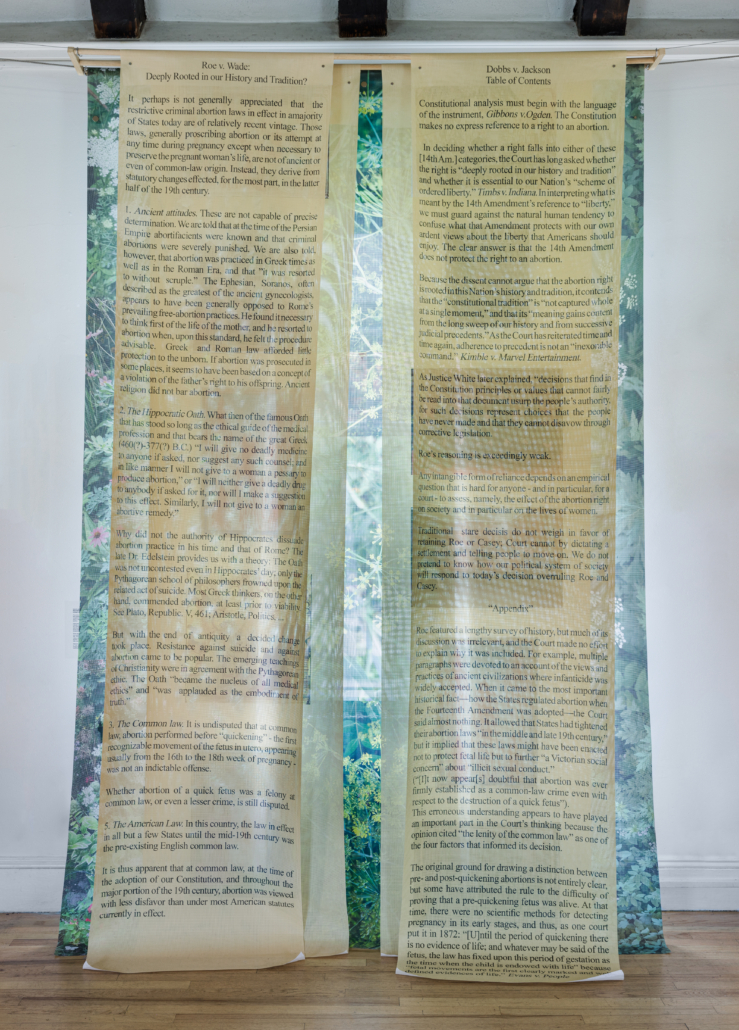
how to perform an abortion (Maureen Connor & Jason M. Leggett)
Penumbra, 2023
Printed mesh curtains, 4 curtains 25 x 116″; 3 curtains 24″ x 116″
Penumbra (def. a partial shadow, as in an eclipse, between regions of complete shadow and complete illumination) is a project and installation that challenges the constitutionality of Dobbs v. Jackson, a decision by the U.S. Supreme Court, June 24, 2022, in which the Court held that the U.S. Constitution does not confer a right to abortion.
Historically, however, justices and scholars have argued that the founding document includes a penumbra: a group of rights implied from other explicitly protected rights. The term gained attention in 1965, when the Griswold v. Connecticut decision established a right to privacy based on the 1791 Bill of Rights and explicitly the First, Fourth, Fifth & Ninth Amendments, in addition to substantive due process rights of the Fourteenth Amendment.
When the Dobbs decision calls attention to the phrase “(not) deeply rooted in our history and tradition” to explain why abortion was not a right granted in the Constitution, we ask, “whose history….whose tradition?” The answer is that abortion history is women’s history, as we draw attention to the millennia-long legacy of women using herbs for abortion and contraception, a “birthright” that is part of a deeply hidden, repressed and often destroyed global practice.
Here we juxtapose selections from Dobbs, placed on a background of images of groups of “men making serious decisions” in relation to selections from Roe, placed on a background of women taking care of other women, all against a background of herbs traditionally used for abortion and contraception.
Photographed by Etienne Frossard.
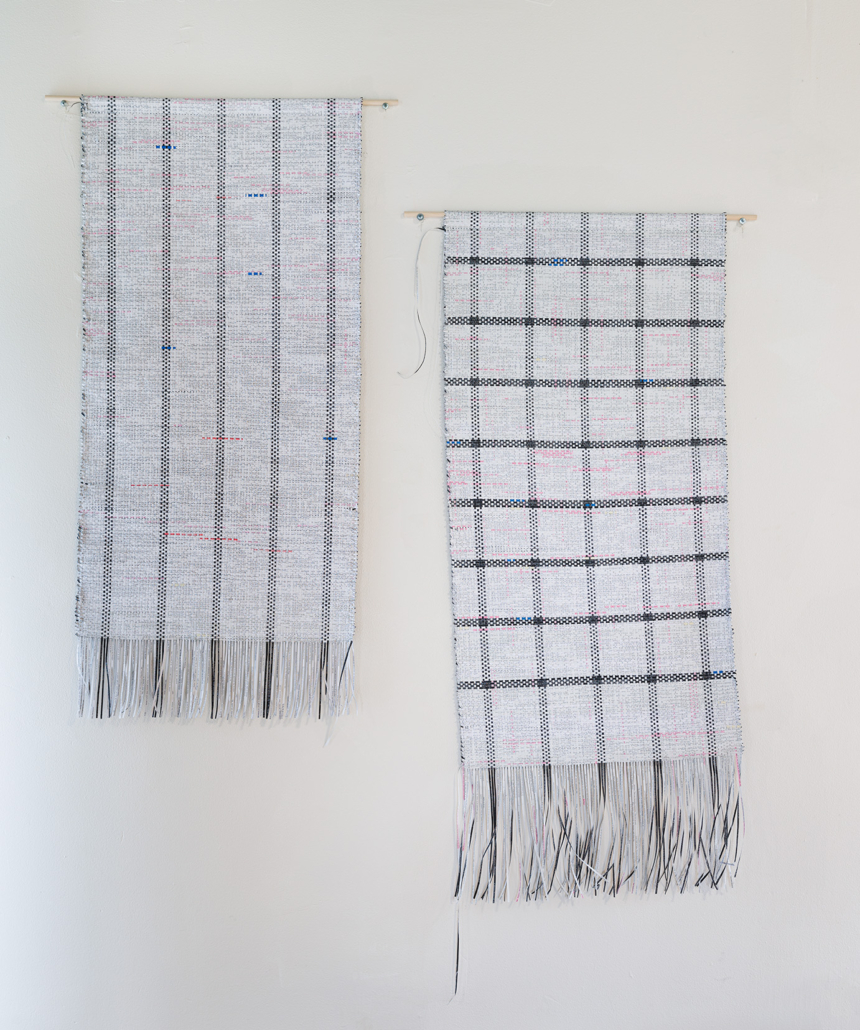
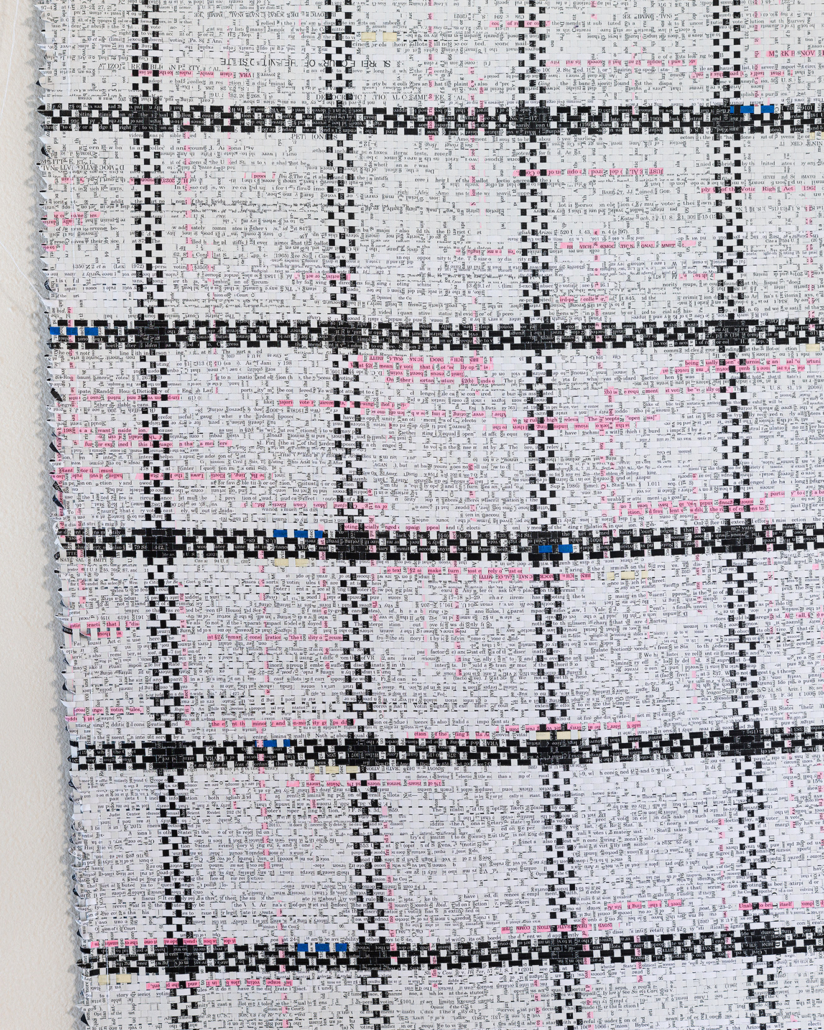
Bang Geul Han
Sam’s Kitchen Towels (Warp and Weft #4), 2023
Paper, glue, thread, 19.5” x 36” each (x 2)
Sam’s Kitchen Towels (Warp and Weft #4) is part of my ongoing series Warp and Weft (2021 – present,) in which I weave together printouts of various legal documents concerning reproductive rights and their intersections with questions of race and class.
This particular piece weaves together two opinions of the U.S. Supreme Court delivered by Justice Samuel Alito: Brnovich v. Democratic National Committee (2021) and Dobbs v. Jackson Women’s Health Organization (2022). These hugely consequential recent rulings weakened the 1965 Voting Rights Act (making it more difficult to challenge discriminatory voting laws in court) and overturned the federal constitutional protections for abortion (established by the previous Roe v. Wade and Planned Parenthood v. Casey rulings), respectively.
Justice Alito’s assertion of his originalist textual interpretation of the Constitution intersects and overlaps through warp and weft, creating a physical manifestation of the interlocking sociopolitical frameworks that perpetuate gendered and racial violence.
Photographed by Etienne Frossard.
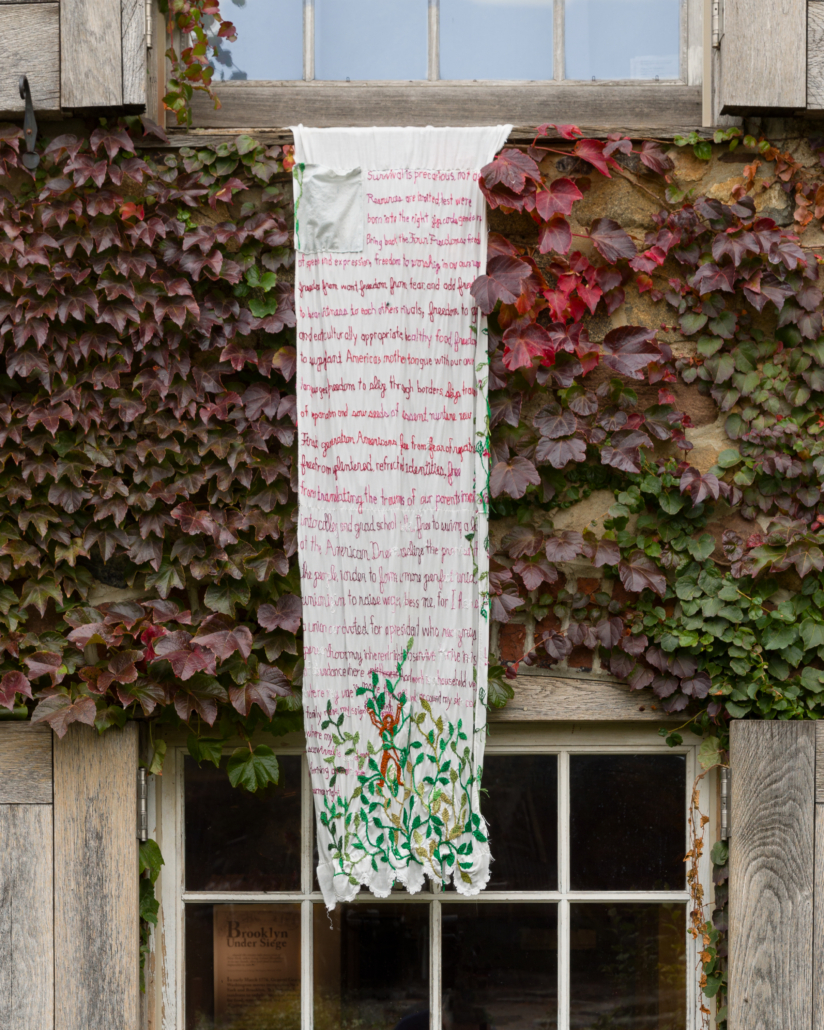
Iviva Olenick
Survival is precarious, not assured, 2019
Embroidery on fabric with indigo-dyed pocket, 50” x 18.5”
$850
I made this piece while creating a series of flags “talking back” to then President Trump, the Constitution as it was originally written, and contemporary interpretations of the Constitution that limit rather than protect personal freedoms. The piece directly advocates for reviving the “Four Freedoms” articulated by President Franklin D. Roosevelt: freedom of speech and expression; freedom to worship in our own ways; freedom from want, freedom from fear. It goes further to advocate for freedom to practice cultural, religious and personal rituals without fear of discrimination or retaliation, and to thrive rather than merely get by.
Photographed by Etienne Frossard.
About the Curator:
Katherine Gressel, the Old Stone House & Washington Park’s Contemporary Art Curator, is a New York‐based curator, artist, and writer focused on site‐specific art. She earned her BA in art from Yale and MA in arts administration from Columbia. Katherine’s previous exhibits dealing with such topics as income inequality, urban agriculture, and parks have been recognized by the New York Times, Time Out New York, Hyperallergic, News 12 Brooklyn, and DNAInfo. In addition to organizing eleven major exhibitions to date at the Old Stone House, Katherine has curated for FIGMENT, No Longer Empty, St. Francis College, and Brooklyn Historical Society, and was the 2016 NARS Foundation emerging curator. She was selected for the 2015 Independent Curators International (ICI) Curatorial Intensive in New Orleans. Katherine has written and presented on public and community art issues for Createquity, Americans for the Arts, and Public Art Dialogue, among others. Katherine also served as Programs Manager at Smack Mellon Gallery from 2010-2014, and has worked and consulted for diverse nonprofits.
Artist Selection Committee:
Steven Mazie, Professor of Political Studies at Bard High School Early College-Manhattan and Supreme Court Correspondent, The Economist; Katherine Toukhy, artist and art educator; Jennifer Wingate, Professor of Fine Arts, Chair, Interdisciplinary Studies, St. Francis College; Katherine Gressel, Contemporary Curator, Old Stone House & Washington Park; Kim Maier, Executive Director, Old Stone House & Washington Park
This exhibition is made possible, in part, by the New York City Department of Cultural Affairs and the New York State Council on the Arts with the support of the Office of the Governor and the New York State Legislature.


